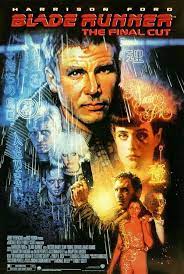
In 2019, in Los Angeles, ex-cop Rick Deckard (Harrison Ford) is picked up by another cop named Gaff (Edward James Olmos) and brought to his former boss Bryant (M. Emmet Walsh). Deckard’s old job was as a Blade Runner and he tracked down bioengineered humans called Replicants and retired them, i.e., shot them. He is told that four replicants are illegally on Earth. Deckard does not want the job but is pressured into it. They watch a video of a Blade Runner named Holden (Morgan Paull) administering the Voight-Kampff Test, designed to distinguish replicants from humans with questions invoking an emotional response. The test-subject, Leon, (Brion James) shoots the interrogator after two questions.
Deckard is supposed to retire Leon and three other Nexus-6 replicants named Roy (Rutger Hauer), Zhora (Joanna Cassidy), and Pris (Daryl Hannah). First, he meets with the CEO of the company that produces replicants, Eldon Tyrell (Joe Turkel), so he can see how the Voight-Kampff test works on Nexus-6 replicants. Tyrell wants to see the test fail first and suggests Deckard administer it to his assistant Rachael (Sean Young). Deckard decides that Rachael is a replicant who thinks she’s human. Tyrell says she has been given false memories.
After searching Leon’s hotel room, Deckard finds photos and a synthetic snake scale. Roy and Leon are meanwhile investigating a lab that makes replicant eyes and learn about J.F. Sebastian (William Sanderson), a genetic designer working for Tyrell. Deckard returns to his apartment and finds Rachael waiting for him. She shows him family photos to prove her humanity, but Decker tells her that her memories are those of Tyrell’s niece, and she leaves in tears. Meanwhile, Pris finds Sebastian’s wonderful toy workshop and charms him completely.
A photograph from Leon’s apartment and the synthetic snake scale point to a strip club where Zhora works. After a chase, Zhora is retired. Deckard is also told to retire Rachael, who has vanished from the Tyrell Corporation. Deckard spots her in a crowd, but he is attacked by Leon. Just as Leon is about to kill him, Rachael kills Leon with Deckard’s gun. They return to Deckard’s apartment and end up in bed.
Roy joins Pris at Sebastian’s toy-filled apartment and tells her that the other replicants are dead. Sebastian reveals that a premature-aging genetic defect will kill him soon, so his lifetime is as short as a replicant’s. Sebastian brings Roy to Tyrell’s penthouse. He demands longer life, but Tyrell says it is impossible, though he praises Roy for what he has accomplished in his short life. Roy kills Tyrell, then Sebastian. Deckard has found his way to Sebastian’s apartment and is ambushed by Pris, but he kills her. Roy’s body is failing, but he chases Deckard through the building and onto the roof, where Roy saves Deckard from falling to his death. Then, after a memorable monologue, Roy dies. Deckard returns to find Rachael in his apartment. They leave the city together.
This is a synopsis of the material that appears in all seven of the different versions, because the studio demanded so many changes. A director’s cut was released in 1992 and a so-called final cut as a 25th Anniversary digitally mastered release, which was the only version under the director’s control.
The director was Ridley Scott, with a script by Hampton Fancher and David Peoples, based on Phillip K. Dick’s 1968 novel Do Android’s Dream of Electric Sheep? Critics, like the studio heads, had no idea what to do with this movie. Now it is considered one of the all-time best SF movies, a true neo-noir or cyberpunk movie, slow-paced and contemplative, featuring an astonishing future city and beautiful music by Vangelis. It led the way to popularity for the undervalued Phillip K. Dick and such movies as Total Recall, Minority Report, and A Scanner Darkly. It is now in the Smithsonian. A sequel, Blade Runner 2049, appeared in 2017.
The term Blade Runner came from a script by beat poet and addict William S. Burroughs of Alan E. Nourse’s novel of that name. A 20-minute reel of the movie was shown to Phillip K. Dick before he died too soon at 54. He praised the world created in it and thought it true to his vision. The film was dedicated to him. The voiceovers were insisted upon by the studio, who as usual thought the public too stupid to follow the story without them. Scott got rid of them as soon as he could. Harrison Ford hated them, and Ridley Scott hated Harrison Ford. The problem was that Ford was way too smart and his ideas about movies were too good. George Lucas no doubt felt the same. Either Ford has mellowed of late, or directors are willing to deal with him because he is box-office gold.
Much of the film was shot at the Bradbury Building in downtown LA. Ridley Scott envisioned the Blade Runner city as a combination of a painting by Edward Hopper, French comic book Métal hurlant, and Hong Kong on a bad day, but it’s basically a high-tech Metropolis. The flying police-cars are called Spinners, and you can’t make an SF cityscape without them now. The brilliant Vangelis score was long delayed and only came out on CD after the 1992 director’s cut release. The special effects are said to be the best of all time. The date of original release of the film was June 25, chosen by Alan Ladd Jr. because Star Wars and Alien had been released on that date. An entire library of film analysis was spawned by the movie. Phillip K. Dick refused $400,000 to write a novelization for 12-year-olds.
Zhora’s snake was actually Joanna Cassidy’s pet, named Darling. Rutger Hauer rewrote his death speech the night before filming it, without telling Ridley Scott. The crew was in tears. Sean Young wears a number of coats that belonged to Greta Garbo. Phillip K. Dick thought Harrison Ford was the perfect Deckard. In Dick’s novel, the androids are just called androids. The term replicants came from screenwriter David Webb People’s daughter. Phillip K. Dick, doing research for The Man in the High Castle, was reading notes by Gestapo agents and came across the phrase “We are kept awake at night by the cries of starving children.” He was so troubled that he began thinking about creatures who look like human beings but are unfeeling machines. Do Androids Dream of Electric Sheep was the result.
